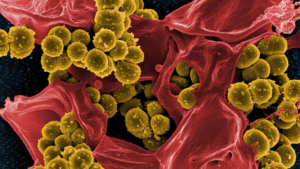
MRSA Infections – MRSA Symptoms – MRSA Prevention Treatment Information for MRSA or Staph Infection.
CA-MRSA – Community Acquired MRSA is now on the increase.
Prevention, however, is better than cure.
Symptoms, Treatment and Prevention Information for MRSA (Methicillin resistant Staphylococcus aureus) infection and Staph Infection is now available through this Section of the Illuminati Silver Website, which has been written by someone who has, over the past 10 years, had success in the treatment of over 2,200 cases.
On this site, we shall give you the medical information required to understand the Methicillin-resistant Staphylococcus aureus bacterium. Our information on MRSA and associated pathogens, along with suggested treatment information provided should enable you to defeat this bacterium, where antibiotics sometimes fail.
This site provides guidance and information protocols for light to severe and life-threatening infections. The author has an unblemished MRSA – VRSA – LRSA – MRSE and Osteomyelitis eradication record that spans several years. Has your doctor told you that your MRSA condition is incurable? He/she may be wrong. Do not suffer because antibiotics are failing – there are non-toxic eradication courses available with no or few side-effects available.
MRSA – Understand the enemy and you can win the war…
What is MRSA?
Methicillin resistant Staphylococcus aureus is a common type of staph bacterium which lives on the skin and in the nasal passages of around 30% of the population. Mostly, this staph aureus bacterium does no harm and does not pose a problem with infection or require a cure. But, like many bacterium, Staphylococcus aureus has the ability to pose a serious infection problem, if you are feeling run down, ill, injured or if you have undergone any form of surgery. It can cause a very serious staph infection, if it enters the body, such as through open wounds, or instruments placed in the body, or by cross-contamination from another patient, nursing staff or specialist. Without the proper medical treatment and medical information, this can lead to death or be difficult to cure.
MRSA and Staph.aureus infections are most commonly transmitted from person to person by touch. It is also possible to acquire MRSA infection from dust containing contaminated skin particles or from objects in the environment, or from surfaces that may be contaminated with the MRSA bacterium.
An antibiotic called Methicillin was used for the treatment and cure of infections caused by staph bacterium. The term ‘Methicillin resistant’ means that this type of antibiotic can no longer kill 100% of the staph bacterium and another antibiotic needs to be used, if available. If Methicillin can no longer be used for the treatment and cure ofStaphylococcus aureus infection, it is medically referred to as MRSA.
The Causation of MRSA
Antibiotics have been in use for many years as a successful treatment and cure for staph infections. However, these antibiotics have been overused, misused and over prescribed as a cure for staph aureus infection for many years. It is fairly common for people to not complete a course of antibiotics, or not use as prescribed. If this happens, it is probable that not 100% of the bacterium that caused the staph infection will have been killed. Surviving staph bacterium develop a resistance to this antibiotic and multiply. As more and more antibiotics are prescribed, the number of staph bacterium that are able to resist those antibiotics become more numerous. The biggest problem with the use of antibiotics, is that they are non-focused. Therefore, they do not discriminate between good and bad bacterium, otherwise known as ‘Flora’ which can be found in the large intestines and form a large part of the body’s immune system. Without this immune system protection, ‘superbugs‘ are free to develop.

